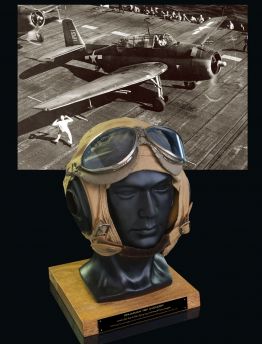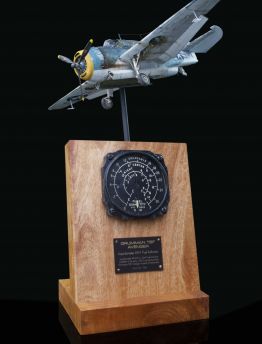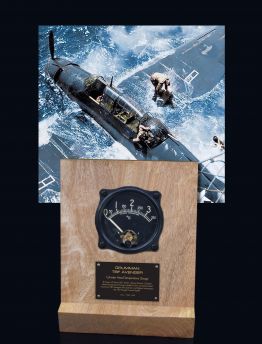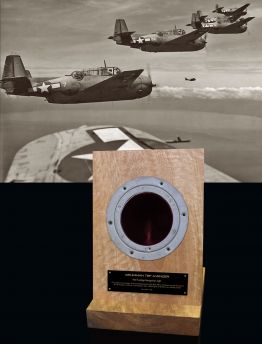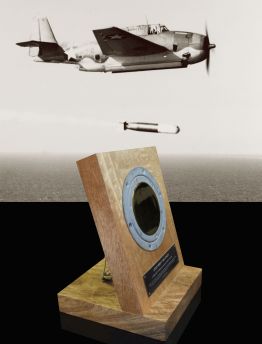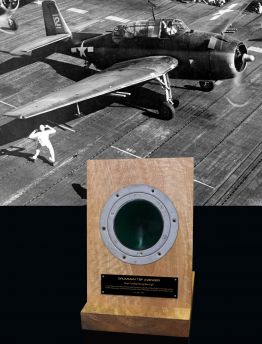- AUST POST SHIPPING
- 0438 654 235
- info@recoverycurios.com
- P.O. Box 7640 Cairns QLD Australia, 4870
-
0
Shopping Cart


GRUMMAN TBF AVENGER
 The Grumman TBF Avenger was one of the first purpose designed and built torpedo bombers to serve with the USN carrier and Marine land-based forces in WWII and replaced the Douglas TBD Devastator which having been first flown in 1935, had by 1939 already become obsolete as aircraft design progressed at breakneck speed with the onset of WWII.
The Grumman TBF Avenger was one of the first purpose designed and built torpedo bombers to serve with the USN carrier and Marine land-based forces in WWII and replaced the Douglas TBD Devastator which having been first flown in 1935, had by 1939 already become obsolete as aircraft design progressed at breakneck speed with the onset of WWII.
As an offensive attack aircraft, the TBF Avenger had a rather auspicious beginning when a ceremony to  open the new Grumman manufacturing plant and introduce the first TBF to the US public occurred on the same day the Japanese Imperial Navy attacked Pearl Harbour.
open the new Grumman manufacturing plant and introduce the first TBF to the US public occurred on the same day the Japanese Imperial Navy attacked Pearl Harbour.
The heaviest single-engined aircraft of WWII, the TBF Avenger (or TBM for General Motors built versions) incorporated the new Sto-Wing ‘compound angle’ folding-wing mechanism designed to maximise storage space on aircraft carriers.
 Its powerful1900hp Wright R-2600-20 Twin Cyclone, fourteen-cylinder, radial engine, gave the Avenger a speed of 271mph with a flight range of over 1000 miles. The Avenger also featured one of the first electrically driven gun turrets with the rear gunner facing aft behind the radio operator/bomb aimer who sat behind the pilot - isolated from the rest of the crew in his fully enclosed cockpit.
Its powerful1900hp Wright R-2600-20 Twin Cyclone, fourteen-cylinder, radial engine, gave the Avenger a speed of 271mph with a flight range of over 1000 miles. The Avenger also featured one of the first electrically driven gun turrets with the rear gunner facing aft behind the radio operator/bomb aimer who sat behind the pilot - isolated from the rest of the crew in his fully enclosed cockpit.
Capable of carrying one Bliss-Levitt Mark 13 torpedo, a single 2,000lb bomb, or up to four 500lb bombs, the Avenger saw its first combat action during the battle of Midway when six TBFs were launched from the USN carrier Hornet along with the rest of the squadron's ageing Devastators.
 Wether due to its inexperienced crew who had only just switched over to the TBFs or the lack of supportive air-cover, only one of the six TBF’s returned, heavily damaged - with one gunner killed and both the bomb aimer and pilot injured.
Wether due to its inexperienced crew who had only just switched over to the TBFs or the lack of supportive air-cover, only one of the six TBF’s returned, heavily damaged - with one gunner killed and both the bomb aimer and pilot injured.
Later with growing American air superiority, better attack coordination and more veteran pilots, the TBF Avenger went onto play a vital role in the subsequent battles against Japanese surface forces with 24 TBF’s sinking the Japanese light carrier the Ryujo and claiming one dive bomber at the cost of seven aircraft during the next major naval battle in the Eastern Solomons.
 During the Battle of Guadalcanal in November 1942, Marine Corp and Navy Avengers also helped sink the Japanese battleship Hiei, which had already been crippled the night before.
During the Battle of Guadalcanal in November 1942, Marine Corp and Navy Avengers also helped sink the Japanese battleship Hiei, which had already been crippled the night before.
One of the Avenger’s most famous pilots was then naval aviator (and future US President) George H. W. Bush whose TBF was shot down over the Pacific island of Chichi Jima. After successfully hitting their target the crew was forced to bail out over water with only the pilot surviving. Rescued at sea by the American submarine Finback, he later received the Distinguished Flying Cross.
Besides the traditional surface role (torpedoing surface ships), Avengers also claimed 30 submarine kills, including the cargo submarine I-52 making them one of the most effective sub-killers in the Pacific theatre, as well as in the Atlantic, when escort carriers were finally available to escort Allied convoys. There, the Avengers contributed to the warding off of German U-Boats while providing air cover for the convoys.
Towards the final year of the war in the Pacific with the Japanese fleet greatly diminished, the TBF was gradually phased out by the Grumman Hellcat.
All Grumman TBF Avenger Instruments listed below come complete with detailed Scale Model, Mango Wood Stand & Plaque plus Printed Fact Sheet featuring photo of instrument in aircraft cockpit.
Return to VINTAGE ORIGINAL AIRCRAFT INSTRUMENTS
- LAND
- SEA
- AIR
- VINTAGE ORIGINAL AIRCRAFT INSTRUMENTS
- HAWKER TYPHOON
- VICKERS WELLINGTON
- FAIREY GANNET
- RYAN ST-A SPORTS TRAINER
- DE HAVILLAND TIGER MOTH
- HAWKER HUNTER
- Mc DONNELL DOUGLAS KC-10 AERIAL TANKER
- SOPWITH CAMEL
- AIRCO DH.1 AND DH.2
- JUNKERS JU 87
- CURTISS C-46 COMMANDO
- HANDLEY PAGE HAMPDEN
- SUPERMARINE SEAFIRE
- B-25 MITCHELL BOMBER
- BRISTOL BLENHEIM
- ENGLISH ELECTRIC LIGHTNING
- HAWKER TEMPEST MkVI
- YAKOVELOV YAK - 3
- FOCKE-WULF FW190
- FOLLAND GNAT
- AIRSPEED OXFORD
- SHORT STIRLING
- AVRO ANSON
- DOUGLAS C-133 CARGOMASTER
- HANDLEY PAGE VICTOR BOMBER
- DE HAVILLAND SEA VENOM
- VICKERS VALIANT BOMBER
- DOUGLAS A-26 INVADER
- GRUMMAN S2F TRACKER
- SUPERMARINE SPITFIRE
- LOCKHEED P2-V NEPTUNE
- P-51 MUSTANG
- BRISTOL BEAUFIGHTER
- DE HAVILLAND MOSQUITO
- B-26 MARTIN MARAUDER
- P3 ORION
- DOUGLAS A-20 HAVOC
- P-39 AIRACOBRA
- AVRO SHACKLETON
- B-17 FLYING FORTRESS
- B-24 LIBERATOR
- MESSERSCHMITT BF-110
- MESSERSCHMITT BF-109
- BRISTOL BEAUFORT
- KAWASAKI Ki-45 (NICK) INTERCEPTOR
- C-130 HERCULES
- CAC BOOMERANG
- AVRO LANCASTER
- GRUMMAN F4F WILDCAT
- F4U VOUGHT CORSAIR
- WESTLAND LYSANDER
- P-47 REPUBLIC THUNDERBOLT
- NORTH AMERICAN T-6 TEXAN - HAVARD
- C-47 SKYTRAIN
- DOUGLAS SBD DAUNTLESS
- CAC WIRRAWAY
- PBY CATALINA
- P-40 WARHAWK
- FAIREY SWORDFISH
- P-38 LIGHTNING
- HAWKER HURRICANE
- CURTISS SB2C HELLDIVER
- GRUMMAN F6F HELLCAT
- SEAKING HELICOPTER
- SEAHAWK HELICOPTER
- DOUGLAS A4G SKYHAWK
- GRUMMAN TBF AVENGER
- HANDLEY PAGE HALIFAX
- DOUGLAS SKYRAIDER AE-1
- GLOSTER METEOR
- JUNKERS JU-88
- F-86 SABRE JET
- SHORT SUNDERLAND
- B-29 SUPER FORTRESS
- F-9F GRUMMAN PANTHER
- F-100D SUPER SABRE
- BELL UH-1 HUEY HELICOPTER
- AVRO VULCAN STRATEGIC BOMBER
- CANBERRA BOMBER
- DHC-4 CARIBOU
- BLACKBURN BUCCANEER
- DE HAVILLAND VAMPIRE JET
- HAWKER SEA FURY
- LOCKHEED HUDSON
- LOCKHEED EC-121 WARNING STAR
- SEPECAT JAGUAR
- HAWKER SIDDELEY NIMROD
- HAWKER SIDDELEY HARRIER
- ARADO AR 196
- VOUGHT OS2U KINGFISHER
- LOCKHEED ELECTRA
- NORTHROP P-61 BLACK WIDOW
- BOEING CH-47 CHINOOK
- LOCKHEED PV-1 VENTURA
- BOEING P26-A 'PEASHOOTER'
- Ilyushin Il-2 ‘Sturmovik’
- WESTLAND WESSEX
- FAIREY FIREFLY
- VINTAGE AVIATION COLLECTABLES
- VINTAGE COLLECTABLE MODEL AIRCRAFT KITS
- RETRO STYLE METAL AIRCRAFT COLLECTABLES
- VINTAGE ORIGINAL AIRCRAFT INSTRUMENTS
